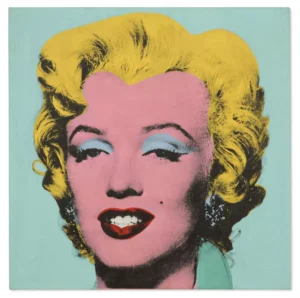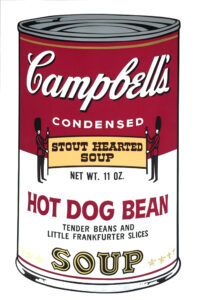Unveiling Most Collectible Warhol Prints: Top Picks

Andy Warhol’s ‘Shot Sage Blue Marilyn’ sets new auction record
Key Highlights
- Andy Warhol’s artwork “The Sage Blue Marilyn” became the most expensive of all his paintings, selling for a staggering USD 195 million at a Christie’s auction in New York.
- The painting Pablo Picasso’s 1955 artwork “Lesmes d’Al (Version ‘O’)” become the most expensive20th-century artwork sold.
- Warhol influenced by art,, and music throughout his career and is best as a legend in pop art.
- Using a cheap quick commercial printing technique Warhol mass-produced silkscreen versions of photographs and other imagery.
- Warhol’s artistic production was characterized by his innovative use of screen printing and his influential studio, known as “The Factory.”
Introduction
Andy Warhol, one of the most iconic figures in the art world, revolutionized the way we perceive art and popular culture. His vibrant and thought-provoking prints continue to mesmerize art enthusiasts across the globe. In this blog, we will delve into the world of Andy Warhol and unveil the top valuable Warhol prints of all time, including his iconic piece, the Birth of Venus by Sandro Botticelli.
From Marilyn Monroe to Campbell’s Soup Cans, Warhol’s prints have become iconic symbols of pop art. His ability to capture the essence of popular culture and blend it with bold colors and repetitive imagery is what sets his artwork apart. Throughout his career, Warhol experimented with various mediums, including painting, printmaking, and even film. His unique approach to art and his exploration of consumerism and celebrity culture, including his fascination with actress Elizabeth Taylor, have made him a revered figure in contemporary art.
In this blog, we will explore the most valuable Warhol prints, each with its own unique story and significance, including the Race Riot (in Four Parts) (USD 62.8m) print inspired by the story of Moore’s photographs. We will also delve into the creation process behind Warhol’s masterpieces, including the role of his famous studio, The Factory, and the revolutionary technique of screen printing. Furthermore, we will discuss Warhol’s influence on contemporary art and culture, as well as provide a guide for enthusiasts looking to collect Warhol prints and ask important questions about the nature and function of media imagery. We will also touch upon the impact of Charles Moore’s photography on Warhol’s work and how it reflects the political and social climate of the 1960s.
Exploring the Most Valuable Warhol Prints of All Time
Andy Warhol’s artwork spans a wide range of subjects, from iconic celebrities like Marilyn Monroe and Elvis Presley to everyday objects like Campbell’s Soup Cans. His prints have not only captured the imagination of art lovers but have also fetched record-breaking prices at auctions, with his portrait of Marilyn Monroe, Shot Sage Blue Marilyn (1964), becoming the highest price ever paid for a Warhol painting. Let’s delve into the world of the most valuable Warhol prints and explore the stories behind them.
1) Marilyn Diptych – A Timeless Icon
One of the most iconic Warhol prints is the Marilyn Diptych, a masterpiece that immortalizes the legendary Marilyn Monroe. This artwork is a diptych, meaning it consists of two panels placed side by side. The left panel consists of vibrant colors portraying multiple images of Monroe, while the right panel fades into black and white, representing her tragic demise. The artwork depicts screen icon Marylin Monroe, against a sage blue background, with a picture of Monroe based on promotional material for her film Niagara (1953) and her distinctive mole, making it a timeless and valuable piece in the art world.
The Marilyn Diptych is a testament to Warhol’s fascination with celebrity culture and his ability to capture the essence of a person through repetition and vibrant colors. It has become an enduring symbol of both pop art and Monroe herself, showcasing Warhol’s unique ability to blend art and popular culture.
2) Campbell’s Soup Cans – The Emblem of Pop Art
Perhaps one of Warhol’s most recognizable and influential works, the Campbell’s Soup Cans series is a collection of 32 paintings, each depicting a different flavor of Campbell’s Soup. This series marked a significant shift in the art world, as it challenged traditional notions of what could be considered art.
By elevating everyday objects to the status of art, Warhol blurred the line between high and low culture and brought ordinary consumer products into the realm of artistic appreciation. The Campbell’s Soup Cans series has since become synonymous with pop art and remains an enduring emblem of Warhol’s artistic vision.

Andy Warhol, Hot Dog Bean, from the Campbell’s Soup II Portfolio, 1969
3) Silver Car Crash (Double Disaster) – A Stark Reflection
Silver Car Crash (Double Disaster) is a haunting and thought-provoking artwork that portrays a twisted and mangled car crash scene. The painting captures the viewer’s attention with its stark imagery and repetitive photographic presentation.
Part of Warhol’s Death and Disaster series, Silver Car Crash explores themes of mortality, violence, and the impact of media imagery on society. It is a reflection on the fragility of life and the ever-present reality of tragedy, specifically warhol’s death. This powerful artwork, based on a photograph depicting a car accident involving the Seattle police, showcases Warhol’s ability to provoke and challenge viewers while making a profound statement about the human condition.
4) Eight Elvises – Merging Music and Art
Eight Elvises is a silkscreen print painting that features eight images of the iconic Elvis Presley side by side on a long canvas. This artwork is unique in its composition and offers a glimpse into Warhol’s fascination with music and its intersection with art.
The repetition of Elvis’s image emphasizes his cultural impact and the idolization of celebrities in popular culture. Eight Elvises is not only a celebration of the King of Rock and Roll but also a reflection on the power of music to shape society and inspire artistic expression. This print, featuring eight images of Elvis Presley, remains one of the most sought-after and valuable Warhol artworks to date, with rumors that it was bought by the state of Qatar.
5) Triple Elvis [Ferus Type] – The King Times Three
Triple Elvis [Ferus Type] is a striking piece where Andy Warhol merges the iconic presences of Elvis Presley into a powerful artistic statement. Depicting Elvis thrice, the artwork symbolizes a triple dose of the legendary King of Rock and Roll. This piece, part of Warhol’s exploration of celebrity culture and mass production, captures the essence of Elvis Presley’s charisma and influence on popular culture. The [Ferus Type] version holds special significance, reflecting the evolution and variation within Warhol’s renowned versions of Double Elvis series.
6) Turquoise Marilyn – Beauty in Blue
Turquoise Marilyn, also known as The Shot Marilyns, is a striking rendition of the iconic Marilyn Monroe, captivates with its serene beauty in light blue tones. This masterpiece by Andy Warhol showcases his mastery in presenting the glamorous Hollywood star in a new light. The subtle yet profound use of color and the repetition of the same image in different color schemes, including turquoise, evokes a sense of tranquility, contrasting with the vibrant aura of Marilyn. Warhol’s interpretation of Marilyn Monroe in light blue offers a fresh perspective, emphasizing her timeless allure and the enduring fascination she exudes in promotional material for her film Niagara.
7) Banana – The Velvet Underground Collaboration
The “Banana” print by Andy Warhol is not just art but a fascinating collaboration with the iconic band The Velvet Underground. This piece, with its unique cover design for the band’s debut album, is a prime example of Warhol’s immersion in music and art. The banana print symbolizes a pivotal moment where music and visual art intersected in a groundbreaking way, solidifying Warhol’s influence beyond traditional artistic boundaries.
Andy Warhol’s Banana, 1967
8) Mao – Political Commentary through Portraiture
Warhol’s “Mao” serves as political commentary through portraiture, reflecting on the cultural and political landscape of his time. This iconic artwork captures the essence of Andy Warhol’s unique ability to blend art with societal critique. By depicting Mao Zedong, the leader of the Chinese Communist Revolution, Warhol delves into the realm of political symbolism and power dynamics. Through this piece, Warhol challenges viewers to contemplate the intersection of art, politics, and social influence.

Andy Warhol, Mao 95, 1972
9) Flowers – A Burst of Color
Warhol’s “Flowers” series is a vibrant burst of color that showcases his unique approach to art. These silkscreen prints depict vivid flowers in a bold and eye-catching manner, embodying Warhol’s fascination with beauty and consumer culture. By presenting nature in a vibrant and larger-than-life way, Warhol challenges traditional notions of art and invites viewers to reconsider the significance of everyday objects. “Flowers” is one of the four paintings in Warhol’s similarly named series, which also includes the famous “Men in Her Life” painting. It remains a beloved series in his body of work, highlighting his ability to transform the ordinary into the extraordinary.

Andy Warhol, Flowers 64, from Flowers Porfolio, 1970
10) Guns – A Controversial Statement
The artwork “Guns” by Andy Warhol stands out as a controversial statement in his body of work. Depicting a stark representation of firearms, it challenges societal views on violence and cultural perceptions of weaponry. This piece serves as a thought-provoking commentary on the prevalence of guns in American culture, prompting viewers to reflect on the implications of gun control and the impact of firearms on society. Warhol’s bold choice to address such a contentious subject through art demonstrates his willingness to engage with pressing social issues.
The Creation Process Behind Warhol’s Masterpieces
Warhol’s masterpieces were often produced at The Factory, his famed studio in New York. Screen printing, a novel technique at the time, revolutionized his artistic reproduction. Through this method, Warhol could mass-produce art, blurring the line between original and replica. His innovative use of synthetic polymer paint and silkscreen ink allowed for vibrant and precise prints. The meticulous process involved in creating each piece contributed to the distinct look and feel of Warhol’s art, cementing his unique place in the art world.

Andy Warhol, Ingrid Bergman With Hat (From “Casablanca”), 1983
The Role of The Factory in Warhol’s Artistic Production
Andy Warhol’s famed studio, The Factory in New York, was the nucleus of his creative universe. It served as a hub for collaboration, experimentation, and innovation. The Factory was not just a workspace; it was a cultural melting pot where artists, musicians, actors, and writers mingled, influencing Warhol’s artistic direction. This dynamic environment fueled Warhol’s prolific output, allowing him to produce iconic works like the Marilyn Monroe series and the Campbell’s Soup Cans. The Factory, with its bohemian aura, played a pivotal role in shaping Warhol’s revolutionary artistic vision.
Screen Printing: Revolutionizing Artistic Reproduction
Screen printing revolutionized artistic reproduction in Warhol’s creations by enabling mass production with consistency. This technique empowered Warhol to replicate images effortlessly, contributing to his iconic status in the art world. The method of screen printing allowed Warhol to produce multiple versions of the same piece while maintaining quality and precision. This innovation not only revolutionized Warhol’s own practice but also influenced a new wave of artists to explore similar techniques in their works, leaving a lasting impact on the realm of contemporary art.
Warhol’s Influence on Contemporary Art and Culture
Warhol’s influence on contemporary art and culture transcends time, resonating in today’s creative landscape. His fusion of art and consumerism paved the way for modern interpretations of visual communication. Pop Art’s enduring impact in the digital age finds roots in Warhol’s boundary-pushing concepts. His legacy bridges the gap between artistic expression and commercial appeal, propelling artists to explore new realms of creativity inspired by his groundbreaking work. Andy Warhol’s imprint on the art world remains indelible, shaping trends and perceptions in current cultural contexts.
Bridging Art and Advertising: Warhol’s Legacy
Warhol’s legacy extends beyond the art world, bridging with advertising to redefine cultural norms. His fusion of commercialism and creativity reshaped perceptions of consumerism. By integrating everyday objects into high art, Warhol made a profound impact on how society views products and brands. This seamless blend of art and advertising marked a revolutionary shift in artistic expression, influencing generations to come. Warhol’s legacy serves as a testament to the power of merging art with commercial appeal, shaping contemporary perspectives on culture and aesthetics.
Pop Art’s Prolonged Influence in Today’s Digital Age
Pop art continues to shape modern culture, resonating in today’s digital landscape through its bold colors and iconic imagery. The fusion of mass media and art, as pioneered by Andy Warhol, can be seen in contemporary design, fashion, and social media aesthetics. The influence of pop art is evident in digital collages, filters mimicking Warhol’s style, and the democratization of art through online platforms. Warhol’s legacy endures, adapting to the digital realm and inspiring new generations of artists.
Collecting Warhol: A Guide for Enthusiasts
Collecting Warhol prints can be a gratifying pursuit for enthusiasts. To ensure authenticity, focus on authentication and provenance. Stay updated on market trends to gauge the evolving value of Warhol pieces. Verify the legitimacy of your print, especially from private sales. Keep an eye on auctions and private collections for potential acquisitions. Understanding the market can help navigate the intricate world of Andy Warhol prints. Remember, knowledge is key in building a valuable collection.
Authentication and Provenance: Ensuring the Legitimacy of Your Warhol Print
Delving into the world of Andy Warhol prints entails a keen eye for authenticity and provenance. When acquiring a Warhol piece, meticulous verification of its origins is vital. Establishing a print’s legitimacy often involves tracing its history back to reputable sources, ensuring it is not a mere replica. Provenance, or the documented chain of ownership, plays a crucial role in cementing the artwork’s authenticity. By scrutinizing these aspects, collectors safeguard themselves against counterfeit pieces and preserve the integrity of their valuable acquisitions.
Market Trends: The Evolving Value of Warhol Prints
The market trends surrounding Andy Warhol prints continue to showcase an upward trajectory in value. With auction houses witnessing fierce bidding wars, the demand for these iconic pieces remains strong. Each new record set reflects the enduring popularity and investment potential of Warhol’s work. Private sales and auctions alike have reached unprecedented levels, solidifying Warhol’s prints as not only artistic treasures but also lucrative financial assets. The evolving landscape of Warhol print values indicates a sustained interest in these timeless creations.
Conclusion
In essence, Andy Warhol’s prints stand as timeless icons of art, each holding a unique story and significance in the realm of contemporary culture. From the iconic Marilyn Diptych to the political commentary portrayed in Mao, these prints not only reflect Warhol’s artistic brilliance but also serve as a bridge between art and society. Understanding the value and creation process behind these masterpieces can truly enrich your appreciation for Warhol’s enduring legacy. Whether you are an enthusiast or collector, delving into the world of Warhol prints offers a fascinating journey through art, culture, and history.
Frequently Asked Questions
What Makes a Warhol Print Valuable?
Exploring the essence of value in Warhol prints delves into cultural impact, rarity, and iconic subjects. Their significance lies in bridging art with society, creating timeless reflections of pop culture.
How Can I Start Collecting Warhol Prints?
Begin collecting Warhol prints by researching reputable dealers and auction houses. Consider your budget, authenticity, and desired piece. Attend art fairs for a diverse selection. Verify provenance and authenticity before making a purchase to build a valuable collection.
How Do I Care for and Preserve Warhol Prints?
To care for and preserve Warhol prints, store them away from direct sunlight, humidity, and temperature fluctuations. Use acid-free materials for framing and consider professional conservation for valuable pieces. Regularly inspect for any damage or discoloration.
https://www.nytimes.com/2021/12/02/arts/design/warhol-religion-museum-review-catholic.html






